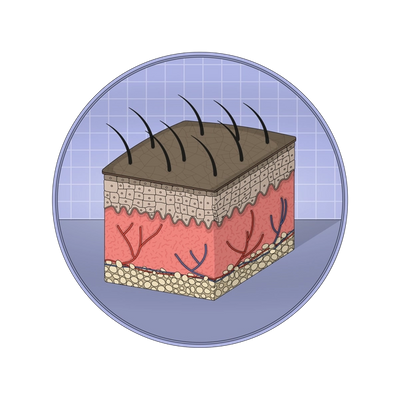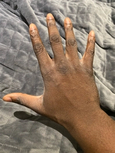Dry Skin
drai -skinDry skin is skin that's losing more moisture than it's able to maintain. It might be itchy, red, or flaking.
Also Called
Dehydrated skin, xerosis
Frequently Found On
Arms, legs, feet, hands

What is dry skin?
Dry skin is skin that isn’t getting properly hydrated or maintaining its moisture content for a variety of reasons (Winter itch? Dry skin.). Itchy skin, red, ashy, burning, scaling, cracked, or flaky skin anywhere on the body are telltale signs. “It could be almost anything,” says Dr. Hope Mitchell, a board-certified dermatologist in Northwest Ohio. “I’ve seen patients present with more crinkled skin, cracks, or fissures (bigger cracks in the skin). They’re almost like those little cuts that you can see on the fingertips. The skin may feel rough. It may feel bumpy. It may look ashy. It may look gray.” In severe cases, especially if someone’s been scratching, there might be lichenification, which is when a patch of skin becomes thick and leathery.
Dermatologists identify skin tones in a range of 1-6, from light tones to dark. People with lighter tones (types 1-3) might have dry skin that’s red or pink, while darker tones (4-6) may hyperpigment, which means the skin has patches of deeper color. In Black skin, dry skin may appear ashy. “It's almost like a dull look to the skin,” says Dr. Mitchell, “You have to have some color in the skin in order to see it, because it’s almost like an undertone of a whitish gray patch in the skin. You really can’t pick that up on skin that doesn’t have color to it.”
What causes dry skin?
Dry skin is caused by a wide range of reasons, from genetics to the weather to aging, which is why it’s so common. One way to think of dry skin is to picture microscopic irritants breaking through the skin barrier (also called “moisture barrier”).1 Skin is here to protect us from the elements (sun, pollution, heat, cold) but sometimes it’s not prepared for battle. The body produces oil, called sebum, that helps the skin maintain moisture, but it produces less as we age. And sometimes that oil is no match for a scalding 22-minute daily shower, handwashing 10 times a day, or a lip-chapping winter walk. That’s when it’s time for reinforcements: moisturizing creams and lotions.
About that skin barrier. The skin has many layers, but when it comes to dry skin, we’re most concerned with the epidermis, the outermost layer and our first line of defense, and the dermis underneath it, where all of the collagen, ceramides, and elastic fibers are that really hydrate and support the skin. “When that breaks down,” warns Dr. Mitchell, “we’re going to have problems.”

Like the rest of the body, skin needs water to function and stay hydrated, as well as a variety of vitamins, antioxidants, lipids, and nutrients usually sourced from food that also happen to be in a lot of skincare.2 A lack in either of those could cause dry skin. Certain cleansers, fragrances, makeup, medications, tight clothing, and laundry detergents can dry out the skin. Aging causes dry skin, as our bodies don’t produce as much sebum (natural oil on the skin)—75% of people over 64 report dry skin conditions. Over-exfoliating can break through the skin barrier. Environmental factors—dry winter air, hot showers, chlorinated pools—are common causes of dry skin. Or it might be plain genetics, a family disposition for drier skin. “The culprit,” says Dr. Mitchell, “is that we have water escaping and not being maintained in the body, and we have irritants that are coming in. We’re losing water, and we’re not able to retain it.”
Underlying immune conditions like eczema (aka “atopic dermatitis”) and psoriasis show up as dry skin patches as well and, if severe, may require a different treatment route and/or professional medical advice vs. the home remedies we’ll go over in the next section. Though not usually the only symptom, dry skin can be the result of underlying medical conditions like hypothyroidism, which is very common in older women. A condition called ichthyosis—chronically dry, painful, and scaly skin—is rare. Dry skin, by and large, is nothing to be concerned about when it comes to your overall health.
How do you treat dry skin?
You might want a moisturizer or lotion that solves all of your dry skin problems—and those certainly help—but “dry skin treatment starts in the shower,” says Dr. Mitchell. She recommends showering for five-to-ten minutes max, using warm but not hot water, and limiting baths, especially when the skin is showing signs of dryness.
In the shower, use gentle products, avoiding anything labeled “antibacterial”—which are good at killing germs, but that’s because they contain skin-drying alcohol. Save it for the hand soap. Dr. Mitchell tells her patients to look for the words “gentle,” “hydrating,” or “pH balancing.” (More on the pH level of skin, see here.)
Putting on moisturizer just once a day may not do it.
—Dr. Hope Mitchell, a board-certified dermatologist, fellow of the American Academy of Dermatology, and member of the Skin of Color Society.
Right out of the shower, immediately moisturize while the skin is still damp, ideally with a cream, not a lotion.3 Creams usually contain more occlusive ingredients (most commonly: petrolatum, mineral oil, lanolin, beeswax), which work as sealants to keep moisture in, while lotions are thinner, with more water. Either way, avoid those that contain drying alcohol-based perfumes. One slather session may not be enough, as one study found that only 50% of cream remained on the skin eight hours after application.4 “If you’re dehydrated in general, drinking lots of water a lot of times won’t bring you back,” she says. “Sometimes you have to get an IV to get you back. The same with dehydrated skin. Putting on a moisturizer just once a day may not do it. You may have to do it three, four times a day until we can get your skin back into balance, back into good condition.”
When your skin is back in healthy, hydrated condition, that’s when it’s safer to take a nice bath, and start slowly incorporating products with ingredients like chemical exfoliants or retinoids to clear away dead skin and help new skin cells emerge to the surface.
How do you prevent dry skin?
In the shower, avoid hot water, harsh scrubs, and soaps with fragrance for especially sensitive skin. Avoiding tight-fitting clothing and switch to a fragrance-free laundry detergent. Regularly moisturize the skin while it’s damp from the shower, and consider using a humidifier if you live in a drier climate, or one that isn’t humid year-round (humidity levels matter: low humidity means less moisture, and having a small device pump mist into the dry air in your space is way easier than applying cream throughout the day). Drinking water and eating a healthy diet—fruits and vegetables—is beneficial in all kinds of body departments, maintaining healthy skin is just one of them.5 Supplements, like vitamin E and C, can also support healthier skin, but studies have shown that using topical products loaded with these vitamins more effectively hydrates the skin by directing them straight to the source.2 Treating dry skin can be a bit of trial and error, dependent on your skin and environment, so every person’s routine will be different.
Citations
1The skin microbiome: impact of modern environments on skin ecology, barrier integrity, and systemic immune programming by Susan L. Prescott, Danica-Lea Larcombe, et al. World Allergy Organization Journal.
2The Roles of Vitamin C in Skin Health by Juliet M. Pullar, Anitra C. Carr, Margreet C. M. Vissers. Nutrients.
3Moisturizers: The Slippery Road by Anisha Sethi, Tejinder Kaur, SK Malhotra, ML Gambhir. Indian Journal of Dermatology.
4Fluorescence spectroscopy: a rapid, noninvasive method for measurement of skin surface thickness of topical agents by L E Rhodes and B L Diffey. National Library of Medicine.
5Discovering the link between nutrition and skin aging by Silke K. Schagen, Vasiliki A. Zampeli, et al. Dermato Endocrinology.
Additional References:
Hyaluronic acid: A key molecule in skin aging by Eleni Papakonstantinou, Michael Roth, George Karakiulakis. Dermato Endocrinology.
Occlusive ingredients in moisturizers by Harvard Health Publishing.
Pathway to Dry Skin Prevention and Treatment by L. Guenther, C.W. Lynde, et al. National Library of Medicine.
Skin acidification with a water‐in‐oil emulsion (pH 4) restores disrupted epidermal barrier and improves structure of lipid lamellae in the elderly by Ana Kilic, Clarissa Masur, et al. The Journal of Dermatology.
Treatment of acne with intermittent and conventional isotretinoin: a randomized, controlled multicenter study by Ayse Akman, Cicek Durusoy, et al. Archives of Dermatological Research.
Urea uptake enhances barrier function and antimicrobial defense in humans by regulating epidermal gene expression by Susanne Grether-Beck, et al. J Invest Dermatol.
Vitamin E and Skin Health by Alexander J. Michel. Oregon State University.
Get Updates
There’s more to come.
Sign up to receive periodical updates on Mass Index, and to be the first to know when Soft Services launches new products. (If we don’t have any updates, we won’t email you.)























